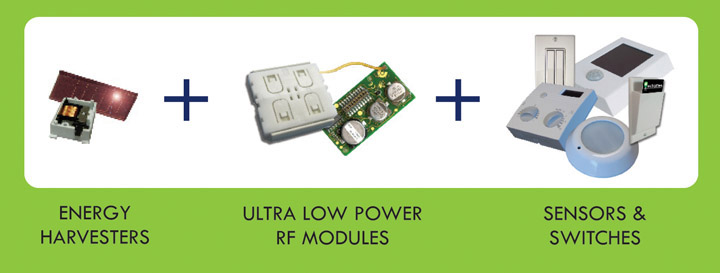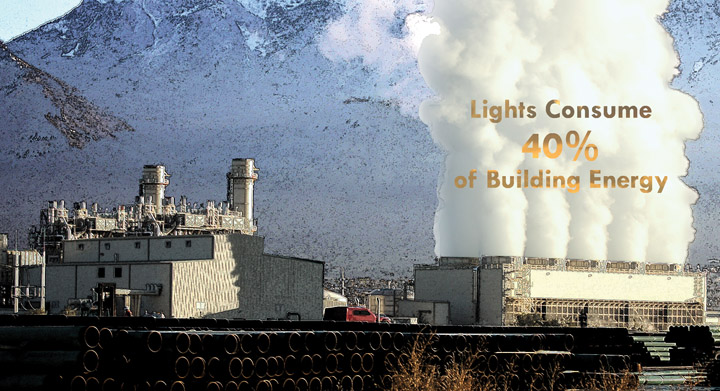This dilemma exposes a colossal challenge and opportunity. While a building owner may clearly see the rewards of installing automated lighting controls, the installation options can be dizzying. Fortunately, technologies have emerged that simplify installations and provide the energy-saving controls that previously seemed out-of-reach for many building owners.

FIGURE 1. Self-powered lighting sensors and switches are the next generation in control technology.
Self-Powered Wireless Sensors and Switches
EnOcean, the inventor of self-powered wireless sensors and switches, combines energy harvesting and wireless technologies to enable solutions for use in simple as well as complex system architecture. Wireless technology is able to generate a signal of astonishing range from an extremely small amount of energy. From just 50 micro Watts, a standard EnOcean wireless module can easily transmit a signal 1,000 ft (150 ft typically indoors - through walls and ceilings). The secret lies in the signal duration; the entire process is started, executed, and completed in no more than a thousandth of a second.When coupled with controls such as sensors and switches, the installation of smart building automation systems is greatly simplified. EnOcean-enabled solutions make use of energy created from slight changes in motion, pressure, light, temperature, or vibration. The captured energy is employed by “peel-and-stick” wireless sensors and switches to transmit data to system controllers. The self-powered controls help make buildings smarter, safer, more comfortable and more energy-efficient.
Don't Get Wired into Yesterday's Thinking
We are entangled in a world that heavily relies on wires. Wires are like the veins in our bodies - absolutely vital. While wires are a necessity and here to stay, some conditions warrant wireless and battery-free solutions. For example, a builder owner in New Jersey needed to convert hundreds of two-way switches into three-way switches. The enormity of the task was greatly reduced with the installer learned that he would not have to pull new wire through the walls, ceilings, and floors. The three-way light switch functionality was accomplished simply by installing two-gang self-powered light switched and electrical load controllers.
FIGURE 2. No wires mean no asbestos exposure in older buildings.
Health Issues Averted
When bypassing the ceilings using wireless and battery-free controls in older buildings, major health issues are also averted. For example, inhaled asbestos resides permanently inside the body. Before it was realized that the inhalation of asbestos could be disabling and even fatal, it was a de facto building material. Each time a ceiling in an older building is penetrated, the risk exists that asbestos is injected into the air, rendering installers vulnerable to serious health risks.If an older building owner wishes to install occupancy-based controls into an existing building, solutions exist that do not require that the installers subject themselves to asbestos. In the case of three-story office building, the health risks were averted by installing self-powered occupancy sensors, self-powered light switches, and electrical load controllers.
The installed energy-conserving controls allowed the building owner to reduce spending on lighting unoccupied rooms. When a room is unoccupied, the lights are automatically turned off. This provides integrators an easy and safe way to comply with new building standards such as California Title 24. This particular mandate requires that lights are manually turned on and automatically turned off when the room is no longer occupied.
Payback and ROI
According to the DOE, lighting represents 40% of the average commercial building’s electric bill. However, only 20% of existing U.S. commercial buildings feature modern lighting technology, while 80% continue to operate lighting systems installed before 1986. In the short term, installers will make a lot of money ridding existing buildings of their inefficiencies. In the long term, building owners and tenants will reap the rewards of occupying energy-efficient buildings. It is estimated that buildings owners will typically recoup the cost of installation in 2.3 years.
FIGURE 3. The Energy Policy Act of 2005 allows building owners to deduct the entire cost of a lighting upgrade, which can add up to big savings.
Government Rebates
The Energy Policy Act of 2005 created the Energy Efficient Commercial Buildings Deduction, which allows building owners to deduct the entire cost of a lighting or building upgrade in the year the equipment is placed in service (subject to a cap).Building owners can reduce operating costs and increase profitability and competitiveness by investing in the highest levels of energy-efficient lighting. For information on how to collect rebates, contact EnOcean at (801) 943-3215.
